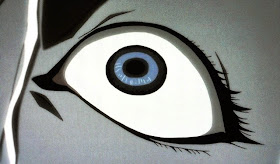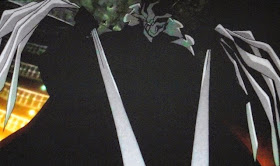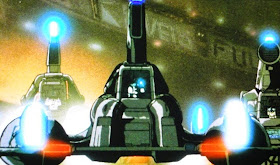"Am I the Angel Of Death? Everything I touch stains with blood. Everyone around me dies."
-Vincent Law-
Like Vincent Law winding his way to his birthplace of Mosk, we return to Ergo Proxy, Episode 8, Shining Sign (Light Beam). Law travels a great distance in search of something but what? The set up and questions continue.


As Law reaches Charos he enters into a skirmish between men in choppers and AutoReivs and he and Pino are nearly killed.
The Rabbit, Law calls it the Senson, comes to a hard landing but appears in one piece. Gosh I love The Rabbit. I want a Rabbit diecast collectible.
Law and Pino are taken into the care of the soldiers but are treated to food and shelter.
The men discuss a story of a monster living underground, but believe it to be a myth.
If RE-L12C41+ focused its narrative thread on Re-l Mayer, Ergo Proxy once again shifts its perspective back to Vincent Law with Shining Sign. Re-l Mayer is removed from this episode's storyline.


The soldiers repair The Rabbit and retrofit it with battle armor requesting Law's help in the battle against AutoReivs despite the fact Law wishes to move on. "Something's weird," says Pino regarding the people of Charos, the place and land Law has reached en route to Mosk.
Two soldiers guard The Rabbit, or the Senson or what the soldiers call The Mosquito. Which is it? Not sure. While on patrol they are brutally attacked and something slaughters the two men literally eviscerating their bodies into bloody heaps. There is indeed a touch of horror to the creepy science fiction that beats at the heart of Ergo Proxy. This cross section and fusion of the two genres, sci-fi and horror, can often be an interesting amalgamation. Films like Event Horizon to recent Anime series like Knights Of Sidonia (2014) or classics like Wicked City (1987) are fine examples of such attempts. Ergo Proxy is mystery that implements both science fiction and horror elements. Those who enjoy both genres should take note.

As a result the men of Charos imprison Law and Pino despite his declaration of innocence.
Law flashes back to all of the trauma that surrounds his presence throughout the series thus far. It often does not end well for those in the company of Vincent Law. Is he cursed? Is he a Proxy? "I don't even know. Maybe inside of me," says Law. From a neighboring cell a woman repeats "bit by bit" that she senses "the pulse of the awakening" (the subtitle assigned for the first episode).
As Law lays tied up in a prison cell there are murmurs of transformation in the air. Is Law's Bill Bixby/Hulk moment on the verge of occurring? Is Law the Proxy he fears?

Meanwhile the soldiers fight swarms of AutoReivs. Are the AotuReivs attacking at the behest of Romdo? Or is this something else? The AutoReivs are attacking the tower of Charos and the underground facility.
As the humans fall a final group of humans attempts to flee on the chopper platform where they are met by a new, exciting and absolutely brutal Proxy, the Senex Proxy, surrounded by and in command of loose-swirling ribbons that straighten, tighten, harden and become sword like blades or strips. It possesses god-like powers. As the chopper attempts an escape and lifts off a missile is shot from the platform in an effort to kill the Proxy creature - the very monster of which the so-called legend spoke of. The creature is untainted and leaps up into the chopper killing the last two men aboard. Is the Proxy working alone or is it working with the AutoReiv invaders?

"The drums of war are beating." Though not witnessed we suspect the Hulk-like transformation moment comes as another Proxy arrives, the one witnessed in the beginning of this series. It must be Vincent Law, the Master, the Ergo Proxy himself.
Ergo Proxy is attacked by the female Proxy and a battle ensues. Light beams move between the eyes of the two Proxies until the female is killed. "When the battle is done, he will bring to this world a gift of death." These are the cryptic words of Ergo Proxy. It is a poetic puzzle in motion each installment.
Law returns in human form. A previously unidentified blonde haired man leans over the dead female Proxy as Pino looks on and asks "Who are you?" Once again, Ergo Proxy leaves us with one of the key philosophical questions regarding identity and existence so often mined in science fiction and anime. Such philosophical ponderings are a beautiful thing when it works effectively in such productions as Ghost In The Shell (1995), Battle Angel Alita (1990-1995) and others.

With the latest installment of Ergo Proxy we are treated to new information, but, of course, given more questions to drive us further into Vincent Law's own heart of darkness and journey. Ergo Proxy makes a good degree of sense out of sometimes confusing components. While one might be tempted to consider Ergo Proxy as crazy ass shit consumed by set up, it is an entirely original affair and one that is at least proving interesting even if the pacing fails to completely grab you by the throat. In this, it is kind of refreshing.
Shining Sign (Light Beam): B+.















































































































